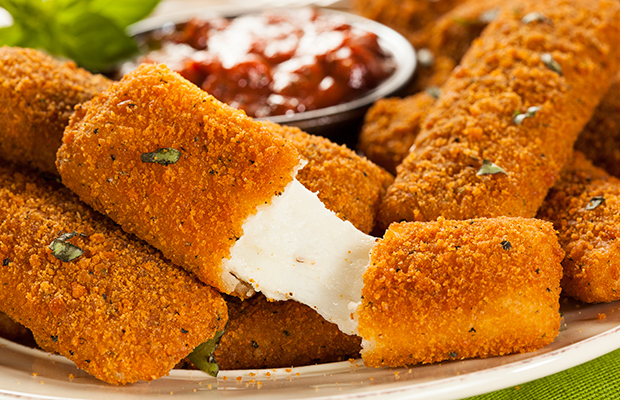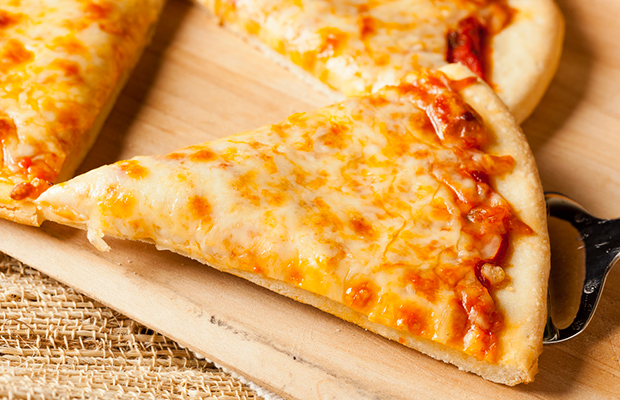
You know how when you get a scrape or a cut, and the area around the wound gets slightly red and swollen? That’s inflammation, a part of your body’s natural response to ward off infection. That’s the good kind of inflammation. But there’s also the bad kind — the chronic, low-grade inflammation that you can’t feel in your body — that’s linked to a whole host of diseases, including depression, cancer, diabetes and heart disease to name just a few.
Here’s the problem: If you can’t see inflammation, and can’t feel it — how do you know where it’s coming from? Well, you might be surprised to know that some experts suspect your lunch (or dinner…or breakfast) could be putting you at risk for disease. Here’s what you need to know about the link between inflammatory foods and your health.
RELATED: What’s Worse: The Calories in Coffee or Candy?
The American Diet and Inflammatory Foods
“It’s like adding a lighted match to a vat of gasoline. You get an explosion of inflammation.”
If you grew up a couple generations ago, you likely would have eaten some protein at every meal, but never more than could fit on the palm of your hand. (Here’s what 25 grams of protein looks like.) Your mother wouldn’t let you leave the table until you ate all your vegetables. And she might even make you choke down a tablespoon of cod liver oil every day, says Barry Sears, PhD, founder of the Inflammation Research Foundation and a leading researcher in the field of anti-inflammatory nutrition. It may seem primitive — but we could actually learn a thing or two from our grandparents about anti-inflammatory diets, he says.
Technically speaking, inflammation occurs when the amount of omega-6 fatty acids you consume outweigh the omega-3 fatty acids. Omega-6s are an essential part of a healthful diet, but they’re also the primary building blocks of pro-inflammatory hormones, says Sears. That’s why no more than two percent of your total daily calories should come from omega-6s.
Today, the average American consumes about eight percent of their calories from omega-6 fatty acids — largely due to our increased consumption of processed foods. At the same time, consumption of anti-inflammatory omega-3 fatty acids — found in fatty fish like salmon, mackerel, sardines, albacore tuna and your grandmother’s cod liver oil — has dropped about 90 percent in the last three decades, he explains.
By themselves, high levels of omega-6 alone won’t necessarily lead to inflammation — unless the body metabolizes them into longer chain fatty acids with the help of the hormone insulin. The problem is that the more refined carbohydrates we eat, the more insulin our bodies produce — and we’re eating more processed, refined carbohydrates than ever before. “When you have high levels of omega-6 acids and high levels of insulin, it’s like adding a lighted match to a vat of gasoline,” says Sears. “You get an explosion of inflammation.”
RELATED: How Bad Is Your Food from 1 to 10? Try This Food Calculator

Are Dairy and Gluten Really to Blame?
Sounds simple: Stock up on salmon and nix the Entenmann’s, and you should be good, right? Not so fast. Just because you understand the science doesn’t necessarily make it any easier to navigate the grocery aisles and understand which foods could cause inflammation.
Some foods have gotten a bad reputation — and don’t deserve it. For example, while some studies suggest a link between dairy and low-grade inflammation, there isn’t evidence that milk products actually cause that inflammation. One review of eight randomized controlled trials found that dairy consumption did not cause increased levels of inflammation.
In addition, everyone’s favorite scapegoat, gluten, which 20 percent of Americans now try to avoid, is also often called inflammatory, though there’s no evidence that gluten causes problems in people without celiac disease, says Academy of Nutrition and Dietetics Spokesperson Lisa Cimperman, MS, RD, LD, clinical dietitian at University Hospitals Case Medical Center in Cleveland.
In fact, eating moderate amounts of any one food won’t likely put you in harm’s way at all.
“The foods that we eat certainly play a role in the inflammatory response; however, single foods are unlikely to exert much effect,” Cimperman says. “Rather, it is the sum of our diet as a whole.”
RELATED: Gym Time or Meal Time: What Matters Most for Weight Loss?
If you want to start fighting inflammation in your own body, you can probably keep the whole-grain bread and focus on ditching these products instead:
Vegetable Oil
Vegetable oils, such as corn, oil, soybean and sunflower oils are rich in omega-6 fatty acids, which could throw your body out of balance, says Sears. Read labels to mine out the omega-6: The more polyunsaturated fat a food product contains, the more omega-6 it contains. Instead, choose snacks and cook with oils higher in monounsaturated fats, such as olive oil, which will contain higher levels of omega-3 fatty acids.
White Carbs
Your body breaks down white bread, pasta, rice and potatoes into glucose even faster than table sugar, says Sears. This increases your insulin levels and creates an environment for inflammation to thrive. Stick to whole grains, which might actually lower your body’s inflammatory response. A 2010 study in The Journal of Nutrition found that eating whole grains lowered levels of inflammatory proteins such as C-reactive protein, which becomes elevated as a response to inflammation in the body.
RELATED: Carbs 101: The Truth About Carbohydrates
Cheeseburgers
Red meat and full-fat dairy are leading sources of saturated fat in the American diet, according to the National Cancer Institute, and research suggests that diets high in saturated fats (found in fatty animal products) can trigger inflammatory responses. There’s no reason to shun burgers entirely, but take one from Cookie Monster and remember that cheeseburgers are should only be a “sometimes food.”
Energy Bars
Many “healthy” store-bought energy bars contain palm kernel oil, which is very rich in palmitic acid, a fat that Sears calls “the bad boy of saturated fats” for its link to increased inflammation. And if that wasn’t bad enough, they usually pack in as much sugar as a candy bar. Reach for a piece of fruit next time you’re in an afternoon slump — or make your own protein bars (like these) at home.

Controlling Inflammation: The Ultimate Balancing Act
Now’s the moment when you point out that your great-uncle lived until 92 on a diet comprised almost entirely of cheeseburgers and Wonder bread. Well, while certain foods are more likely to trigger an inflammatory response than others, the extent really depends on the person. Genetics comes into play a bit here, says Sears. Just as some people can smoke a pack of cigarettes a day and never get sick, others can eat junk food every day and never experience the effects of inflammation.
Your overall diet also plays a major role, says Sears. If you eat a ton of omega-6 fatty acids but you don’t consume a lot of of simple sugars or white carbs, then you won’t make very much insulin, and therefore you won’t produce inflammation. “It’s [the] combination of the diet that determines how much inflammation you will produce,” he says.
Luckily, with simple tweaks, you can change the balance of omega-3 to omega-6 in your diet within just 30 days simply by cleaning up your diet, Sears says. To accomplish this, he suggests dividing your plate into three equal sections, with two-thirds of the plate filled with colorful fruits and vegetables and a third of the plate with low-fat protein. You’ll know you’re in the healthy zone if you eat a meal and then feel no hunger and no fatigue for the next five hours, he says.
“The bad news is you have to do it every five hours for the rest of your life to maintain inflammation in that zone. The good news is it’s easy,” says Sears.
